Discovering Aviles Street: The Oldest Street in St. Augustine
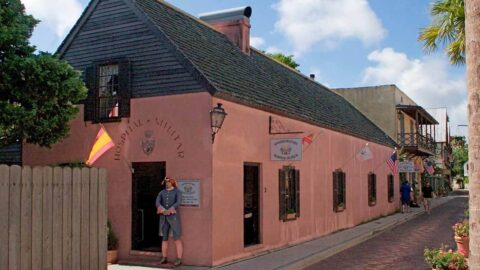
Aviles Street in St. Augustine is a hidden gem that beautifully blends history, art, and culture. As the oldest street in the nation, Aviles Street invites visitors to take a stroll back in time while enjoying the vibrant atmosphere of modern-day St. Augustine. The street’s brick paths and centuries-old buildings create an ambiance that transports you to a different era, offering a unique and immersive experience. Whether you’re an art enthusiast, a history buff or simply looking for a charming place to explore, Aviles Street is a destination that promises to delight.
History of Aviles Street
Aviles Street holds a special place in American history as the oldest street in the United States. Archaeological digs have uncovered pottery shards from the early 1600s beneath its brick-paved pathways, confirming its age and historical significance. These findings provide a tangible link to the past, offering a unique glimpse into the life of early settlers in what was once a bustling colonial outpost. Established during the Spanish colonial era, Aviles Street served as a central hub for commerce, social gatherings and daily life in the growing settlement of St. Augustine. The street’s position near the water made it an ideal location for early settlers who depended on the nearby bay for trade and transportation.
The historical importance of Aviles Street extends beyond its colonial roots. In the 1930s, the street transformed into St. Augustine’s first artist district. The shift began when the Hamblin Hardware warehouse at 11 Aviles Street was converted into studio and gallery spaces, attracting local artists and fostering a creative community. This transformation established Aviles Street as a center for artistic expression that remains vibrant today. Visitors can still experience this artistic spirit in the numerous galleries and workshops that line the street.
A visit to Aviles Street also brings you to the Father Miguel O’Reilly House Museum, one of the oldest structures in the city. Built in the late 17th century, this museum offers insights into the lives of St. Augustine’s early residents, highlighting the city’s Spanish heritage. As you walk along the narrow bricked street, it’s easy to imagine a time when Aviles Street was a dirt road in a fledgling colonial settlement over 450 years ago, serving as a vital artery for the small but growing community. The preservation of its historical charm makes Aviles Street an essential stop for anyone interested in exploring St. Augustine’s past.
Fun Facts About Aviles Street
- Aviles Street is the oldest street in the United States, with a history that dates back to the early 1600s, as confirmed by archaeological finds that unearthed artifacts beneath its surface.
- The street became the birthplace of St. Augustine’s arts district in the 1930s, providing a space for artists to thrive and showcase their creativity in the city’s historic heart.
- Aviles Street was once known as Hospital Street because it was home to the second Spanish military hospital, which provided essential medical care to soldiers and settlers during the colonial era.
- Today, Aviles Street is a cultural hub, home to numerous art galleries, museums, and boutique shops that showcase the creativity and heritage of St. Augustine.
- The Father Miguel O’Reilly House Museum, located on Aviles Street, offers a window into the colonial period with its well-preserved structure and fascinating artifacts from the 1700s.
- The street’s brick pathways and preserved colonial architecture offer a picturesque setting, making it a favorite spot for photographers seeking to capture the charm of historic St. Augustine.
- Aviles Street’s unique blend of history, art and culture makes it a popular destination for both locals and tourists looking to explore the city’s storied past.
- In 2000, St. Augustine officially became a sister city to Avilés, Spain.
Know Before You Go
 Transportation
Transportation
While Aviles Street is best explored on foot to fully appreciate its charm, the Old Town Trolley offers a convenient option for those wanting to see more of St. Augustine. The trolley stops near Aviles Street, providing a narrated tour that highlights the city’s rich history, including Aviles Street’s role in St. Augustine’s development.
Parking
Visitors can find limited street parking near Aviles Street, with several nearby parking lots offering paid options. The Historic Downtown parking facility is a convenient spot for those planning to spend the day exploring the area and nearby attractions.
Accessibility
The street is pedestrian-friendly, but its brick pathways can be uneven in some areas, so comfortable walking shoes are recommended. The charm of the brick and coquina structures is best appreciated at a leisurely pace, allowing visitors to take in the street’s unique atmosphere.
Photo Opportunities
Aviles Street is a photographer’s dream with its historical facades, artistic murals and vibrant street life. Bring a camera to capture the beauty of the Spanish Colonial architecture, the intricate details of the buildings and the lively atmosphere that makes Aviles Street special.
Local Events
Aviles Street often hosts cultural events, art walks, and live music performances, making it a lively part of St. Augustine’s arts scene. Checking the local calendar before your visit can help you catch one of these vibrant events, adding an extra layer of excitement to your trip.
Dining Options
Aviles Street is dotted with cozy cafes and eateries offering a range of culinary delights, from fresh seafood to locally inspired dishes. It’s the perfect place to relax with a meal after a day of exploring the art galleries and historic sites along the street.
Architecture
The historic buildings along Aviles Street reflect the city’s Spanish colonial heritage, with many structures featuring coquina stone, stucco facades, and classic architectural details. The street’s architecture is a testament to the resilience and craftsmanship of St. Augustine’s early settlers, making it a must-see for those interested in history and design.
Things To Do on Aviles Street
Explore the Spanish Military Hospital Museum
Step back in time with a visit to this museum where exhibits detail medical practices from the colonial era. The guided tours offer fascinating insights into how early doctors treated patients using herbal remedies, including the medicinal plants that grew in the region, and rudimentary medical tools. You’ll gain a new appreciation for the challenges of early medicine and the ingenuity of those who cared for the settlers of St. Augustine.
Visit the Father Miguel O’Reilly House Museum
This historic house, built in 1691, offers a deep dive into St. Augustine’s colonial past. The museum showcases artifacts from the Spanish colonial period, including religious relics and household items, telling the story of the city’s early Catholic heritage. It’s a must-see for history enthusiasts and anyone curious about the daily life of early residents.
Browse Local Art Galleries
Aviles Street remains a thriving arts district, home to galleries that display a diverse range of works from local artists. From traditional paintings that reflect Florida’s natural beauty to modern sculptures with contemporary flair, there’s something to inspire every art lover. Many galleries host special exhibitions throughout the year, offering new perspectives on regional and international art.
Dine at Local Bistros
Aviles Street offers a variety of dining options, with charming cafes and bistros where you can enjoy everything from a light lunch to a gourmet dinner. Many establishments offer outdoor seating, perfect for soaking in the street’s vibrant atmosphere while enjoying a meal. Try locally caught seafood dishes or savor a coffee while watching the world go by on this historic street.
Catch Live Music
Throughout the year, Aviles Street hosts live performances that add to its lively ambiance. From jazz bands to folk musicians, the music scene on Aviles Street provides a soundtrack that complements its historical charm. Enjoy an evening under the stars with live music drifting through the air as you explore the street’s unique offerings.
Shop for Antiques and Crafts
Aviles Street’s boutiques offer unique finds, from handcrafted jewelry to vintage treasures. It’s an ideal place to pick up a special souvenir or a one-of-a-kind gift for loved ones. The shops are perfect for browsing, offering a range of items that reflect the rich history and creative spirit of St. Augustine.
Join a Guided Tour
To fully appreciate Aviles Street’s history, consider joining a guided tour. Knowledgeable guides share stories about the street’s past, its role in St. Augustine’s development, and the architectural details that make it unique. It’s a great way to learn more about the city’s history while enjoying the charming surroundings.
Things To Do Nearby
 Visit the Lightner Museum
Visit the Lightner Museum
Just a short walk from Aviles Street, the Lightner Museum is housed in the historic Alcazar Hotel. Its collection includes art, antiques, and curiosities that span centuries, offering a fascinating glimpse into the Gilded Age and the luxurious lifestyle of St. Augustine’s past. The museum’s architecture and beautifully landscaped gardens are also worth exploring.
 Explore Flagler College
Explore Flagler College
This architectural masterpiece was once the luxurious Ponce de Leon Hotel. Visitors can take guided tours of the campus, which include a look at the stunning Tiffany stained-glass windows and ornate interiors. The college’s grand hallways and courtyards offer a breathtaking example of Spanish Renaissance Revival architecture, making it a must-see for architecture enthusiasts.
 Stroll Down St. George Street
Stroll Down St. George Street
A pedestrian-only street, St. George Street is another must-visit in St. Augustine’s Historic District. It’s lined with shops, restaurants, and historic landmarks, making it a perfect complement to a visit to Aviles Street. The street offers a lively atmosphere, with street performers and local vendors adding to the charm.
FAQs
What is the oldest street in St. Augustine?
Aviles Street is the oldest street in St. Augustine, and indeed, the entire United States. It dates back to the early 1600s, making it a significant historical landmark with roots that trace back to the city’s founding. The street’s history is evidenced by archaeological finds and well-preserved structures, offering a rich narrative of the city’s past.
What are the best restaurants on Aviles Street?
Aviles Street is home to a variety of dining options, from charming cafes offering light bites to bistros with full dinner menus. Popular spots include those known for their fresh seafood, locally sourced ingredients and cozy, welcoming atmospheres, perfect for a relaxed meal. Many of these eateries offer outdoor seating, allowing diners to enjoy their meals while taking in the historic surroundings of Aviles Street.
Are there any special events held on Aviles Street?
Yes, Aviles Street frequently hosts events that celebrate its artistic heritage and community spirit. From monthly art walks where galleries open their doors to showcase new exhibits to seasonal festivals featuring local crafts, music, and food, there’s often something happening on this vibrant street. Checking local listings before your visit can help you plan around these exciting events, ensuring you make the most of your time on Aviles Street.
What is Aviles Street known for?
Aviles Street is renowned for its rich history as the oldest street in the nation, its thriving arts scene and its well-preserved Spanish Colonial architecture. It offers a unique blend of history and modern culture, making it a favorite destination for visitors looking to experience the heart of St. Augustine. The street’s charm lies in its brick pathways, intimate art galleries and sense of stepping back in time as you explore its many attractions.

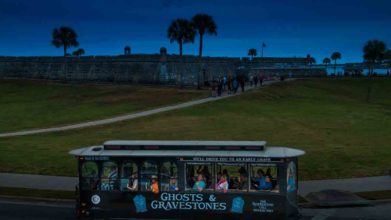
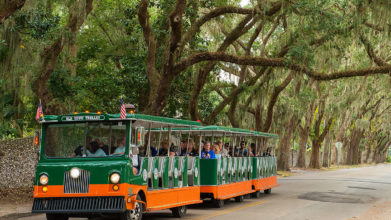


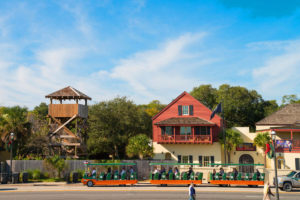 Transportation
Transportation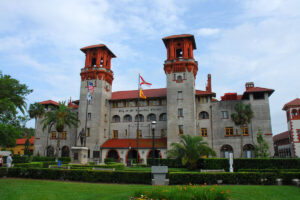 Visit the Lightner Museum
Visit the Lightner Museum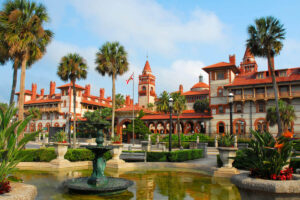 Explore Flagler College
Explore Flagler College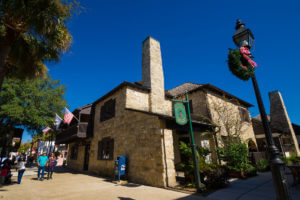 Stroll Down St. George Street
Stroll Down St. George Street